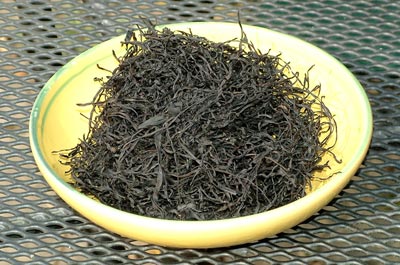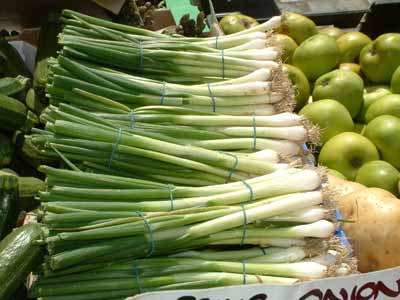
Sea oak. Dark greenish-brown seaweed with long, wavy fronds which is dried in the wind. It is rich in calcium and has a delicate, sweetish mild flavour. It is sold dried and shredded and can be an ingredient in traditional Japanese miso soup or flavoured with soy sauce and lemon for salads. It should be soaked for 15-20 minutes in fresh water until tender before use. Arame should be soaked for 10-15 minutes before used, during which time it will double in volume. It should then be rinsed and drained. It is often served as a side dish, sautéed with tofu and onions or carrots. It is similar to wakame.
When a large fish, say tuna, is not fresh enough for grilling or to be used for sashimi, it is simmered in stock with soy sauce, mirin, saké and sometimes vegetables. This is known as aradaki or arani.
"Hailstone." A bite-size, crisp, wheat cracker, which can be sweet or savoury, with soy sauce, sesame and seaweed.
Crisp, paper-thin sheets of purple laver, an edible seaweed. Iran. It is used for wrapping sushi and for flavouring.
Indian hemp seeds. These are not narcotic and are a component of the traditional seven-spice mixture shichimi togarashi, in which they are used whole.

There are several varieties of Japanese onion, but long onions (naganegi), green onions (bannonegi), and baby spring onions (US: scallions, salad onions) or chives (asatsuki) are the most common. The green leaves are a good source of nutrients such as carotene and vitamins B1, B2 and C, and also contain a digestive aid. The white part of the long onion, which generally is preferred to the leaves, should be glossy and firm. It is used in soups and nabe dishes and as a seasoning or condiment. Baby spring onions (US: scallions, salad onions) or chives, the thinnest among the onions, are usually chopped and used as a seasoning in soups and nabe (a variety of communal one-pot meals) and noodle dishes. Asatsuki are one of the principal sansai or "mountain vegetables", signifying the arrival of spring.